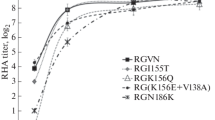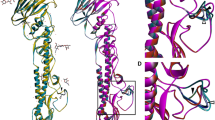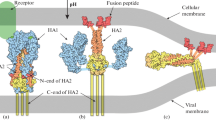Abstract
Mutations in the hemagglutinin (HA) protein molecule of influenza A viruses associated with the virus’s resistance to physical and chemical factors can play important roles in the selection of influenza variants during circulation in nature. In this study, we examined escape mutants of the A/mallard/Pennsylvania/10218/84 (H5N2) influenza virus, which were selected with a monoclonal antibody specific to an epitope in the large HA subunit (HA1). We obtained escape mutant m4F11(4), which carries a single amino acid substitution S145P1 in the HA1 subunit and two other mutants, m4G10(10) and m4G10(6), which accumulated additional mutations in the small subunit (HA2), i.e., L124F2 and L124F2+N79D2, respectively. We demonstrate that amino acid substitutions in HA2 of m4G10(10) and m4G10(6) viruses can compensate for the negative effect of the S145P1 mutation, which manifested in a significant increase in the capacity for viral replication at the early stages of infection in chicken embryos, as well as in growth in the HA thermostability compared with the m4F11(4) escape mutant. We propose that these variations in phenotypic properties, which provide advantages during viral replication, play a role in the positive selection factor and are retained in the viral population.
Similar content being viewed by others
References
Claas E.C., de Jong J.C., van Beek R., Rimmelzwaan G.F., Osterhaus A.D. 1998. Human influenza virus A/HongKong/156/97 (H5N1) infection. Vaccine. 16, 977–978.
Subbarao K., Klimov A., Katz J., Regnery H., Lim, W. Hall H., Perdue M., Swayne D., Bender C. 1998. Characterization of an avian influenza A (H5N1) virus isolated from a child with a fatal respiratory illness. Science. 279, 393–396.
Kaverin N.V., Rudneva I.A., Ilyushina N.A., Varich N.L., Lipatov A.S., Smirnov Y.A., Govorkova E.A., Gitelman A.K., Lvov D.K., Webster R.G. 2002. Structure of antigenic sites on the haemagglutinin molecule of H5 avian influenza virus and phenotypic variation of escape mutants. J. Gen. Virol. 83, 2497–2505.
Rudneva I.A., Kushch A.A., Masalova O.V., Timofeeva T.A., Klimova R.R., Shilov A.A., Ignatieva A.V., Krylov P.S., Kaverin N.V. 2010. Antigenic epitopes in the hemagglutinin of Qinghai-type influenza H5N1 virus. Viral. Immunol. 23, 181–187.
Smirnov Y.A., Lipatov A.S., Van Beek R., Gitelman A.K., Osterhaus A.D., Claas E.C. 2000. Characterization of adaptation of an avian influenza A (H5N2) virus to a mammalian host. Acta Virol. 44, 1–8.
Rudneva I.A., Timofeeva T.A., Ignatieva A.V., Shilov A.A., Krylov P.S., Ilyushina N.A., Kaverin N.V. 2013. Pleiotropic effects of hemagglutinin amino acid substitutions of H5 influenza escape mutants. Virology. 447, 233–239.
Shubladzde A.K., Gaidamovich S.Ya. 1964. Kratkii kurs prakticheskoi virusologii (A Concise Course in Practical Virology). Moscow: Medgiz.
Kushch A.A., Klimova R.R., Masalova O.V., Fedorova N.E., Botikov A.G., Fediakina I.T., Burtseva E.I., Isaeva E.I., Deriabin P.G., L’vov D.K. 2008. Monoclonal antibodies to highly pathogenic avian influenza A(H5N1) strain isolated in the Russian Federation: Development and properties. Vopr. Virusol. 53, 9–14.
Masalova O.V., Klimova R.R., Chichev E.V., Fediakina I.T., Loginova S.Y., Borisevich S.V., Bondarev V.P., Deryabin P.G., Lvov D.K., Kushch A.A. 2011. Development of monoclonal antibodies to highly pathogenic avian influenza H5N1 virus and their application to diagnostics, prophylaxis, and therapy. Acta Virol. 55, 3–14.
Webster R.G., Laver W.G. 1980. Determination of the number of nonoverlapping antigenic areas on Hong Kong (H3N2) influenza virus hemagglutinin with monoclonal antibodies and the selection of variants with potential epidemiological significance. Virology. 104, 139–148.
Rogers G.N., Pritchett T.J., Lane J.L., Paulson J.C. 1983. Differential sensitivity of human, avian, and equine influenza A viruses to a glycoprotein inhibitor of infection: selection of receptor specific variants. Virology. 131, 394–408.
Reed L.J., Muench H. 1938. A simple method of estimating fifty per cent endpoints. Am. J. Hygiene. 27, 493–497.
Philpott M., Easterday B.C., Hinshaw V. 1989. Neutralizing epitopes of the H5 hemagglutinin from a virulent avian influenza virus and their relationships to pathogenicity. J. Virol. 63, 3453–3458.
Krenn B.M., Egorov A., Romanovskaya-Romanko E., Wolschek M., Nakowitsch S., Ruthsatz T., Kiefmann B., Morokutti A., Humer J., Geiler J., Cinatl J., Michaelis M., Wressnigg N., Sturlan S., Ferko B., Batishchev O.V., Indenbom A.V., Zhu R., Kastner M., Hinterdorfer P., Kiselev O., Muster T., Romanova J. 2011. Single HA2 mutation increases the infectivity and immunogenicity of a live attenuated H5N1 intranasal influenza vaccine candidate lacking NS1. PLoS ONE. 6, 1–12.
Wiley D.C., Wilson I.A., Skehel J.J. 1981. Structural identification of the antibody-binding sites of Hong Kong influenza hemagglutinin and their involvement in antigenic variation. Nature. 289, 373–378.
Wilson I.A., Skehel J.J., Wiley D.C. 1981. Structure of the hemagglutinin membrane glycoprotein of influenza virus at 3 Å resolution. Nature. 289, 366–373.
Stevens J., Blixt O., Tumpey T.M., Taubenberger J.K., Paulson J.C., Wilson I.A. 2006. Structure and receptor specificity of the hemagglutinin from an H5N1 influenza virus. Science. 312, 404–410.
Casali M., Banta S., Zambonelli C., Megeed Z., Yarmush M.L. 2008. Site-directed mutagenesis of the hinge peptide from the hemagglutinin protein: enhancement of the pH-responsive conformational change. Protein Eng. Des. Sel. 21, 395–404.
Reed M.L., Yen H.L., DuBois R.M., Bridges O.A., Salomon R., Webster R.G., Russell C.J. 2009. Amino acid residues in the fusion peptide pocket regulate the pH of activation of the H5N1 influenza virus hemagglutinin protein. J. Virol. 84, 3568–3580.
Reed M.L., Bridges O.A., Seiler P., Kim J.K., Yen H.L., Salomon R., Govorkova E.A., Webster R.G., Russell C.J. 2010. The pH of activation of the hemagglutinin protein regulates H5N1 influenza virus pathogenicity and transmissibility in ducks. J. Virol. 84, 1527–1535.
Il’iushina N.A., Rudneva I.A., Varich N.L., Lipatov A.S., Webster R.G., Kaverin N.V. 2003. Antigenic structure of influenza A virus subtype H5 hemagglutinin: Mechanism of acquiring stability to monoclonal antibodies in escape-mutants. Mol. Genet. Mikrobiol. Virusol. 1, 40–45.
Kordyukova L.V., Serebryakova M.V., Polyansky A.A., Kropotkina E.A., Alexeevski A.V., Veit M., Efremov R.G., Filippova I.Y., Baratova L.A. 2011. Linker and/or transmembrane regions of influenza A/Group-1, A/Group-2, and type B virus hemagglutinins are packed differently within trimers. Biochim. Biophys. Acta. 1808, 1843–1854.
Xu R., Wilson I.A. 2011. Structural characterization of an early fusion intermediate of influenza virus hemagglutinin. J. Virol. 85, 5172–5182.
Goh G.K., Dunker A.K., Uversky V.N. 2009. Protein intrinsic disorder and influenza virulence: The 1918 H1N1 and H5N1 viruses. Virol. J. 6, 1–12.
DuBois R.M., Zaraket H., Reddivari M., Heath R.J., White S.W., Russell C.J. 2011. Acid stability of the hemagglutinin protein regulates H5N1 influenza virus pathogenicity. PLoS Pathogens. 7, 1–12.
Timofeeva T.A., Rudneva I.A., Mochalova L.V., Bovin N.V., Kaverin N.V. 2013. Effect of mutations changing the antigenic specificity on the receptorbinding activity of the influenza virus hemagglutinin of H1 and H5 subtypes. Vopr. Virusol. 58, 24–27.
Kaverin N.V., Rudneva I.A., Ilyushina N.A., Lipatov A.S., Krauss S., Webster R.G. 2004. Structural differences among hemagglutinins of influenza A virus subtypes are reflected in their antigenic architecture: Analysis of H9 escape mutants. J. Virol. 78, 240–249.
Author information
Authors and Affiliations
Corresponding author
Additional information
Dedicated to the Enlightened Memory of Professor Nikolai Veniaminovich Kaverin, Member of the Russian Academy of Sciences
Original Russian Text © A.V. Ignatieva, T.A. Timofeeva, I.A. Rudneva, A.A. Shilov, O.V. Masalova, R.R. Klimova, A.A. Kushch, N.A. Ilyushina, N.V. Kaverin, 2015, published in Molekulyarnaya Biologiya, 2015, Vol. 49, No. 2, pp. 342–350.
Rights and permissions
About this article
Cite this article
Ignatieva, A.V., Timofeeva, T.A., Rudneva, I.A. et al. Effect of amino acid substitutions in the small subunit of the avian H5N2 influenza virus hemagglutinin on selection of the mutants, resistant to neutralizing monoclonal antibodies. Mol Biol 49, 303–311 (2015). https://doi.org/10.1134/S002689331502003X
Received:
Accepted:
Published:
Issue Date:
DOI: https://doi.org/10.1134/S002689331502003X




